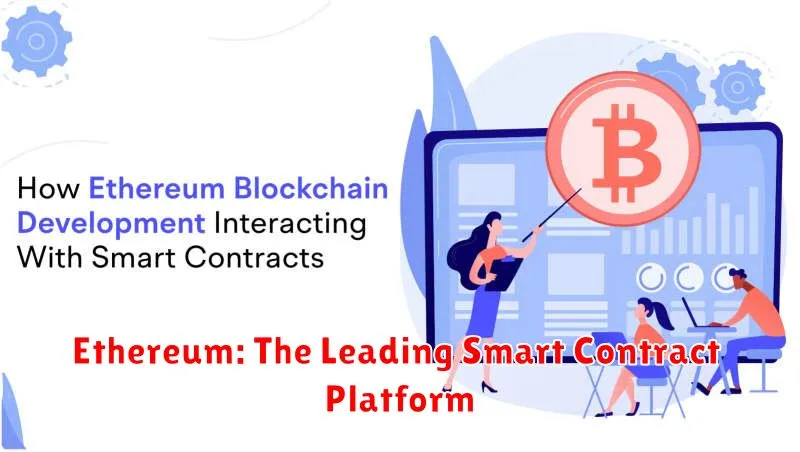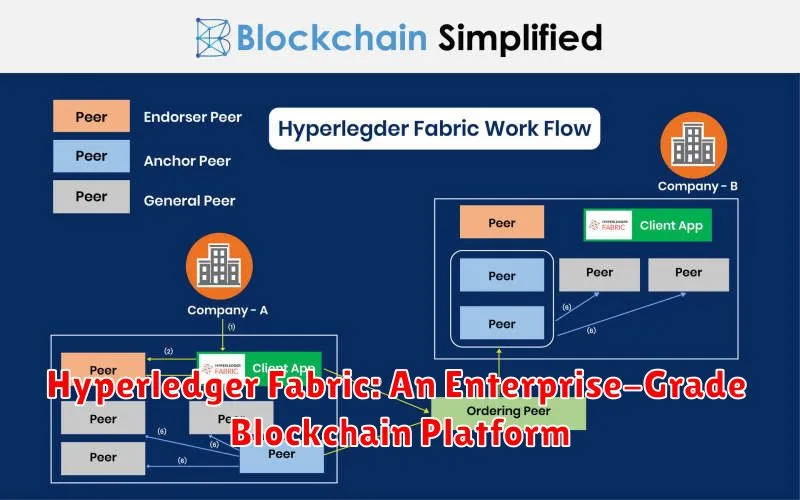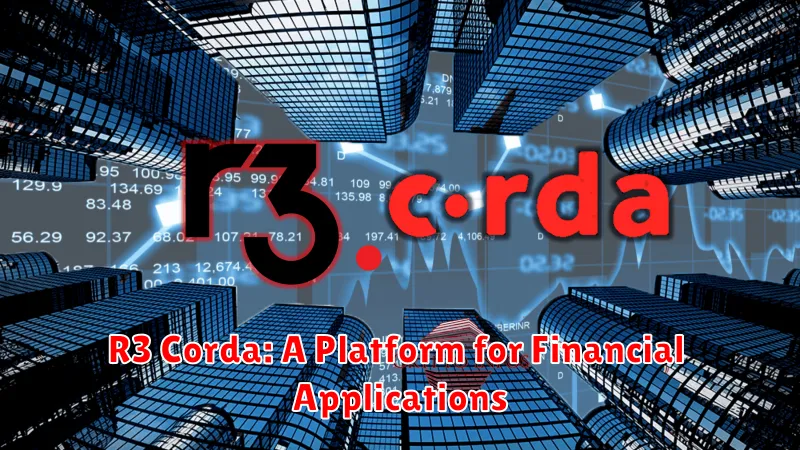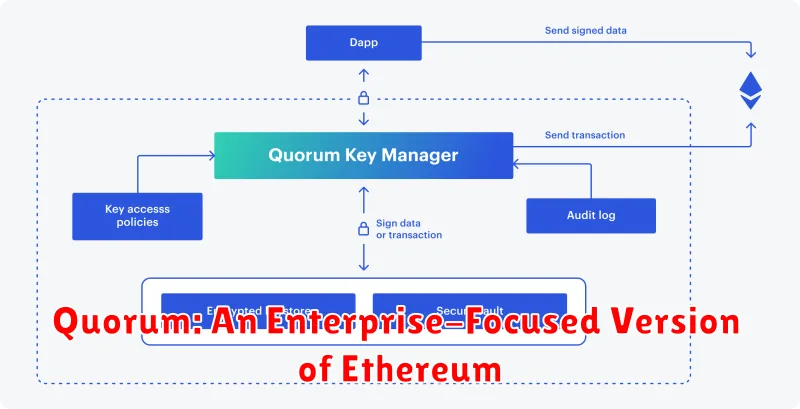The world of decentralized applications (dApps) is rapidly evolving, offering exciting possibilities for innovation and disruption across various industries. At the heart of this revolution lies blockchain technology, a powerful tool enabling secure and transparent transactions. But embarking on the journey of building dApps can seem daunting, with a multitude of blockchain development platforms vying for your attention. This comprehensive guide aims to demystify the landscape, providing a clear understanding of the different platforms available and their strengths, helping you choose the best fit for your project.
From established giants like Ethereum and Hyperledger Fabric to emerging contenders like Solana and Polkadot, the blockchain development ecosystem is teeming with diverse options. Each platform boasts unique features, including programming languages, consensus mechanisms, and scalability capabilities. Understanding these nuances is crucial for developers to make informed decisions and select the platform that aligns with their specific dApp requirements. Whether you’re building a decentralized finance (DeFi) application, a non-fungible token (NFT) marketplace, or a supply chain management system, this guide will equip you with the knowledge to navigate the blockchain development landscape effectively.
Introduction to Blockchain Development Platforms
Blockchain development platforms are the foundations upon which decentralized applications (dApps) are built. They provide the essential tools and infrastructure for developers to create and deploy secure, transparent, and immutable applications on a blockchain network.
These platforms offer a variety of features and functionalities, including:
- Smart contract development: Allows developers to create self-executing contracts that automate processes and ensure agreement between parties.
- Tokenization: Enables the creation and management of digital assets on the blockchain.
- Decentralized storage: Provides secure and tamper-proof storage for data and applications.
- Consensus mechanisms: Ensure the integrity and security of the blockchain network.
- APIs and SDKs: Provide interfaces for developers to interact with the blockchain and its functionalities.
Choosing the right blockchain development platform is crucial for building successful dApps. Key considerations include:
- Programming language support: The platform’s supported languages should be familiar and suitable for the project.
- Scalability and performance: The platform should be able to handle the expected volume of transactions and operations.
- Security: The platform’s security features and reputation should be robust and trustworthy.
- Community and ecosystem: A strong community and ecosystem can provide support, resources, and collaboration opportunities.
In the following sections, we’ll delve deeper into the key aspects of blockchain development platforms and explore some popular options available today.
Understanding Blockchain Technology and its Benefits
Before diving into blockchain development platforms, it’s essential to grasp the core concepts of blockchain technology. In essence, a blockchain is a distributed, immutable ledger that records transactions across a network of computers. This decentralized nature ensures transparency, security, and trust, making it a revolutionary technology with vast potential across various industries.
Here are some key benefits of blockchain technology:
- Transparency and Traceability: All transactions are recorded on the blockchain, making them publicly auditable and easily traceable. This enhances accountability and reduces the risk of fraud.
- Security and Immutability: Once a transaction is recorded on the blockchain, it cannot be altered or deleted, ensuring data integrity and preventing manipulation.
- Decentralization: Blockchain networks operate without a central authority, eliminating single points of failure and enhancing resilience. This promotes greater control and autonomy for participants.
- Efficiency and Cost-Effectiveness: By automating processes and eliminating intermediaries, blockchain can streamline operations and reduce costs significantly.
Types of Blockchain Platforms
Blockchain platforms are the foundations upon which decentralized applications (dApps) are built. They offer a secure, transparent, and immutable ledger for recording transactions and storing data. The choice of blockchain platform is crucial for developers, as it dictates the features, functionalities, and limitations of the dApp. Different platforms cater to diverse needs and use cases, making it essential to understand the available options. Here’s a breakdown of the major types of blockchain platforms:
Public Blockchains
Public blockchains are open to anyone, with no restrictions on participation. This means anyone can join the network, contribute to its security, and run a node. Examples include Bitcoin and Ethereum. Public blockchains are known for their high level of decentralization and security, but they can also be slower and more expensive than other options.
Private Blockchains
Private blockchains are controlled by a single entity or organization. They offer greater control over the network, but also limit participation and transparency. Examples include Hyperledger Fabric and R3 Corda. Private blockchains are suitable for applications where security and confidentiality are paramount, such as supply chain management and financial transactions.
Consortium Blockchains
Consortium blockchains are a hybrid of public and private blockchains. They are governed by a group of organizations, offering a balance between decentralization and control. Examples include Hyperledger Besu and Quorum. Consortium blockchains are often used for industry-specific applications, where collaboration and shared data are essential.
Permissionless Blockchains
Permissionless blockchains allow anyone to join the network and participate in consensus mechanisms. They are typically public blockchains and offer a high degree of decentralization. Examples include Bitcoin and Ethereum.
Permissioned Blockchains
Permissioned blockchains require authorization to join the network. They are typically private or consortium blockchains, providing greater control and security. Examples include Hyperledger Fabric and R3 Corda.
The choice of blockchain platform depends on the specific requirements of the dApp. Public blockchains are ideal for open and transparent applications, while private and consortium blockchains are better suited for secure and controlled environments. Understanding the differences between these types of platforms is crucial for making informed decisions during blockchain development.
Key Features of a Blockchain Development Platform
A blockchain development platform provides the tools and infrastructure needed to create and deploy decentralized applications (dApps) on a blockchain. These platforms offer a range of features designed to streamline the development process and ensure the security and efficiency of dApps. Here are some key features you should look for in a blockchain development platform:
Smart Contract Development
At the heart of any dApp lies the smart contract, an automated agreement stored on the blockchain. A good development platform should provide a robust environment for writing, testing, and deploying smart contracts using languages like Solidity, Vyper, or Rust.
Consensus Mechanism
The consensus mechanism determines how the network reaches agreement on the state of the blockchain. Different platforms offer various consensus mechanisms, each with its advantages and disadvantages. Some popular options include Proof-of-Work (PoW), Proof-of-Stake (PoS), and Delegated Proof-of-Stake (DPoS).
Development Tools and Libraries
A well-equipped platform offers a rich ecosystem of tools and libraries to aid in development. This can include integrated development environments (IDEs), debugging tools, and libraries for common functionalities, such as data storage and communication.
Scalability and Performance
As your dApp grows, it’s crucial to choose a platform that can handle increasing transaction volume and complexity. Look for features like sharding, parallel processing, and optimized network design to ensure scalability and performance.
Security and Auditability
Security is paramount in blockchain development. The platform should offer features like security auditing tools, formal verification techniques, and robust cryptography to protect against vulnerabilities and attacks.
Community and Support
A thriving community and strong support system are invaluable for blockchain developers. Look for platforms with active forums, documentation, and developer resources to help you navigate challenges and get assistance when needed.
By understanding these key features, you can choose a blockchain development platform that aligns with your project requirements and helps you build secure, scalable, and innovative dApps.
Top Blockchain Development Platforms
The world of blockchain development is vast and brimming with potential. As the demand for decentralized applications (dApps) continues to soar, choosing the right development platform becomes crucial. Here’s a look at some of the top contenders:
Ethereum
Ethereum is the undisputed king of blockchain development platforms. Its robust smart contract functionality and thriving developer community make it a popular choice. Ethereum’s EVM (Ethereum Virtual Machine) provides a standardized environment for deploying and running dApps. However, its scalability limitations have led to the emergence of alternative platforms.
Hyperledger Fabric
For enterprises seeking a secure and permissioned blockchain platform, Hyperledger Fabric stands out. It offers privacy and confidentiality features, making it ideal for supply chain management, healthcare, and financial applications. Its modular architecture allows for customization, catering to specific business needs.
Quorum
Developed by JP Morgan, Quorum is a permissioned blockchain platform known for its scalability and enterprise-grade security. It offers privacy-preserving features and a robust consortium model, enabling collaboration among different organizations.
Corda
Another enterprise-focused platform, Corda specializes in financial applications. Its interoperability features enable seamless integration with existing financial systems. Corda’s focus on privacy and confidentiality makes it ideal for transactions requiring strict data protection.
EOS
EOS emphasizes scalability and performance, offering a high-throughput blockchain. Its delegated proof-of-stake (DPoS) consensus mechanism ensures fast transaction speeds. EOS is a strong contender for dApps requiring quick processing times.
Choosing the Right Platform
The best blockchain development platform depends on your specific needs. Consider factors such as:
- Scalability
- Security
- Privacy
- Developer tools
- Community support
Ethereum: The Leading Smart Contract Platform

Ethereum is a decentralized, open-source blockchain platform that allows developers to build and deploy smart contracts and decentralized applications (dApps). It’s considered the leading platform for smart contracts due to its robust features and vibrant community.
Smart contracts are self-executing contracts written in code and stored on the blockchain. They automate agreements, eliminating the need for intermediaries and ensuring transparency and security. Ethereum’s ability to execute these contracts has opened up a world of possibilities for building innovative dApps.
Here are some key features that make Ethereum a dominant platform:
- Turing-complete programming language: Ethereum uses Solidity, a high-level programming language, allowing developers to write complex logic into their smart contracts.
- Strong community and ecosystem: Ethereum boasts a large and active community of developers, researchers, and enthusiasts, contributing to its growth and innovation.
- Decentralization: The platform operates on a decentralized network, meaning no single entity controls it, ensuring censorship resistance and security.
- Scalability: Ethereum is constantly evolving to address scalability concerns through solutions like layer-2 scaling solutions and sharding.
Ethereum’s success has inspired other blockchain platforms, but it remains the most widely used and trusted platform for building decentralized applications. Its versatility, security, and vibrant community make it a prime choice for developers seeking to leverage blockchain technology.
Hyperledger Fabric: An Enterprise-Grade Blockchain Platform

Hyperledger Fabric, a prominent member of the Hyperledger Project hosted by the Linux Foundation, stands as a robust and flexible blockchain platform purpose-built for enterprise-grade applications. Designed with scalability and modularity in mind, Hyperledger Fabric empowers businesses to securely and efficiently manage their data and processes in a decentralized manner.
At its core, Hyperledger Fabric leverages a permissioned blockchain model, meaning that participation in the network is restricted to authorized entities. This approach ensures greater control and allows organizations to implement access policies, granting specific permissions to participants. By establishing trust and transparency among involved parties, Hyperledger Fabric fosters a collaborative environment for shared data management.
One of the key strengths of Hyperledger Fabric lies in its modular architecture, offering flexibility in configuring and deploying solutions tailored to specific business needs. Organizations can select and integrate various components, such as consensus mechanisms, membership services, and smart contracts, to create a customized blockchain ecosystem.
Furthermore, Hyperledger Fabric boasts a highly scalable architecture. It is capable of handling a large number of transactions per second, making it ideal for demanding applications with high volumes of data. This scalability is achieved through parallel processing and efficient data management techniques.
The platform also places a strong emphasis on privacy and confidentiality. Hyperledger Fabric incorporates mechanisms like channel-based communication and data partitioning to ensure that sensitive information is only accessible to authorized parties. This feature is particularly valuable for industries dealing with confidential data, such as finance and healthcare.
In conclusion, Hyperledger Fabric is a powerful and versatile blockchain platform catering to the specific needs of enterprises. Its permissioned architecture, modularity, scalability, and emphasis on privacy and confidentiality make it a leading choice for building secure, transparent, and efficient decentralized applications.
R3 Corda: A Platform for Financial Applications

R3 Corda is a permissioned distributed ledger technology (DLT) platform that has gained popularity in the financial services industry. It’s designed specifically to support the development of decentralized applications (dApps) tailored for financial transactions. Corda’s focus on privacy and confidentiality makes it a compelling choice for institutions looking to streamline processes and improve efficiency within their ecosystems.
One of Corda’s key strengths lies in its private and permissioned nature. This means that transactions are only visible to the parties involved, ensuring confidentiality and regulatory compliance. This is particularly crucial for financial applications where sensitive data needs to be protected.
Corda uses a state machine model for transactions, ensuring that every transaction is validated and recorded in a secure and transparent manner. This approach enhances accountability and eliminates the possibility of double-spending.
Furthermore, Corda’s modular architecture empowers developers to build custom solutions tailored to specific financial needs. This flexibility allows for the creation of dApps that address diverse challenges in areas like trade finance, securities settlement, and regulatory reporting.
Some of the most notable features of R3 Corda include:
- Privacy and Confidentiality: Transactions are only visible to the participating parties, ensuring data security.
- Secure and Transparent Transactions: The state machine model ensures that all transactions are validated and recorded accurately.
- Modular Architecture: Developers can build customized solutions to meet specific financial requirements.
- Interoperability: Corda is designed to integrate seamlessly with existing systems and infrastructure.
- Robust Community Support: R3 has fostered a thriving community of developers and experts who contribute to the platform’s growth.
R3 Corda’s focus on privacy, security, and efficiency, coupled with its modular architecture, makes it an ideal platform for building innovative financial applications that streamline processes, reduce costs, and enhance trust within financial ecosystems.
Quorum: An Enterprise-Focused Version of Ethereum

Quorum is a permissioned, enterprise-grade version of Ethereum, specifically designed for business applications. It leverages the robust capabilities of the Ethereum platform while introducing key features to address the unique requirements of organizations.
Key Features of Quorum:
- Privacy: Quorum offers built-in privacy features, allowing organizations to restrict access to sensitive data within their blockchain network.
- Permissioning: It enables controlled access and membership, granting permission to specific entities to participate in the network.
- Consensus Mechanisms: Quorum supports various consensus mechanisms, including Raft and Istanbul BFT, ensuring secure and reliable transaction processing.
- Scalability: It scales to accommodate high transaction volumes and complex business processes, making it suitable for enterprise applications.
- Interoperability: Quorum seamlessly integrates with existing systems and applications, facilitating smooth adoption within organizations.
Benefits of Quorum for Businesses:
- Enhanced Security: The permissioned nature and robust consensus mechanisms provide a high level of security, safeguarding sensitive data and operations.
- Improved Efficiency: Streamlined workflows and automated processes optimize business operations, reducing costs and increasing efficiency.
- Transparency and Trust: The immutable and auditable nature of blockchain technology promotes transparency and trust among stakeholders.
- Increased Agility: Quorum facilitates rapid development and deployment of decentralized applications, enabling businesses to adapt quickly to changing market conditions.
Quorum empowers businesses to leverage the transformative potential of blockchain technology in a secure and controlled environment. It serves as a foundation for building decentralized applications that address specific business challenges and drive innovation.
EOS: A High-Performance Blockchain Platform

In the ever-evolving world of blockchain technology, EOS stands out as a high-performance platform designed to handle a vast number of transactions per second (TPS). Unlike traditional blockchains like Bitcoin and Ethereum, which struggle with scalability limitations, EOS boasts an impressive architecture that prioritizes speed and efficiency. This makes it a compelling choice for building decentralized applications (dApps) that demand high throughput and real-time responsiveness.
One of EOS’s key innovations is its use of a Delegated Proof-of-Stake (DPoS) consensus mechanism. DPoS empowers a select group of 21 block producers to validate and process transactions, thereby achieving significantly faster transaction times compared to other consensus mechanisms. This optimized approach has enabled EOS to reach an impressive theoretical TPS of millions, making it a formidable force in the blockchain landscape.
EOS also offers a suite of developer-friendly tools and features, including:
- WebAssembly (WASM) support: EOS leverages WASM for efficient execution of smart contracts, enhancing performance and security.
- Account abstraction: EOS simplifies account management by allowing users to create and manage multiple accounts easily.
- Built-in resource management: EOS provides a robust mechanism for managing resources like CPU, RAM, and bandwidth, ensuring fair and efficient resource allocation.
EOS’s focus on performance and scalability has attracted developers seeking to build high-performance dApps. The platform has found applications in diverse domains, including gaming, supply chain management, and social media. As the blockchain space continues to evolve, EOS remains a significant player, pushing the boundaries of what’s possible with decentralized technology.
Choosing the Right Blockchain Development Platform
Choosing the right blockchain development platform is a crucial step in building decentralized applications (DApps). Each platform offers unique features, advantages, and limitations. To make an informed decision, you need to consider several factors, including your project’s requirements, development experience, and desired scalability.
Factors to Consider
- Scalability: Consider the potential growth of your DApp and ensure the platform can handle the expected transaction volume and user base.
- Security: Choose a platform with strong security features and a proven track record of resisting attacks.
- Development Tools and Resources: Evaluate the availability of libraries, frameworks, and documentation to support efficient development.
- Community and Support: Access to a vibrant developer community and reliable support is vital for troubleshooting and learning.
- Cost: Analyze the costs associated with platform fees, transaction fees, and development resources.
- Smart Contract Language: Understand the programming language used for building smart contracts on the platform and its ease of use.
- Consensus Mechanism: Consider the platform’s consensus mechanism and its impact on transaction speed and energy consumption.
Popular Blockchain Development Platforms
Several popular platforms cater to different needs:
- Ethereum: A leading platform known for its flexibility and robust developer ecosystem.
- Hyperledger Fabric: Designed for enterprise-grade applications, emphasizing privacy and scalability.
- R3 Corda: Focuses on financial institutions and offers features for interoperability and regulatory compliance.
- Quorum: A permissioned blockchain platform built on Ethereum, emphasizing privacy and control.
- EOS: Aims for high scalability and fast transaction speeds, suitable for demanding applications.
Conclusion
Selecting the right blockchain development platform is a strategic decision. Carefully assess your project requirements and evaluate the strengths and weaknesses of each platform to ensure you choose the one that best aligns with your goals.
Challenges and Considerations in Blockchain Development
While blockchain technology offers exciting possibilities for building decentralized applications (dApps), several challenges and considerations must be addressed during development.
Scalability
As the number of transactions on a blockchain network increases, the ability of the network to process them efficiently can become a bottleneck. Scalability challenges can lead to slow transaction speeds and high fees.
Security
Blockchain networks are designed to be secure, but vulnerabilities can still exist. Developers must prioritize security measures to protect against attacks such as hacking, malware, and denial-of-service (DoS) attacks.
Regulation and Compliance
The regulatory landscape surrounding blockchain technology is rapidly evolving. Developers need to stay informed about relevant regulations and ensure their applications comply with applicable laws.
Interoperability
Different blockchain platforms have varying technical standards and protocols. Achieving interoperability, the ability for different blockchains to communicate and exchange data seamlessly, is a significant challenge.
Developer Expertise
Building blockchain applications requires a specialized skill set. Developers need a strong understanding of cryptography, distributed systems, and smart contracts.
Cost and Time
Developing a blockchain application can be time-consuming and expensive. This includes costs associated with infrastructure, development, and ongoing maintenance.
User Experience
Blockchain applications can be complex for users to understand and interact with. Developers must prioritize creating user-friendly interfaces and experiences.
By understanding and addressing these challenges, developers can navigate the complexities of blockchain development and build robust and successful dApps.
The Future of Blockchain Development
The future of blockchain development is bright, filled with exciting possibilities for revolutionizing industries and creating new solutions. The technology is still young, but it is rapidly evolving and becoming increasingly accessible. Here are some key areas where blockchain development is poised to have a significant impact:
Decentralized Finance (DeFi)
DeFi is a rapidly growing sector of the blockchain ecosystem that aims to disrupt traditional financial services. With DeFi, users can access financial services like lending, borrowing, and trading without the need for intermediaries like banks. This has the potential to empower individuals and create a more transparent and equitable financial system.
Non-Fungible Tokens (NFTs)
NFTs are unique digital assets that can represent ownership of anything from digital art to virtual real estate. The NFT market is booming, with applications ranging from gaming and collectibles to music and even physical assets. NFTs have the potential to revolutionize the way we create, own, and trade digital assets.
Supply Chain Management
Blockchain can be used to create transparent and secure supply chains, tracking the origin and movement of goods from raw materials to consumers. This can help businesses improve efficiency, reduce fraud, and build trust with customers.
Identity Management
Blockchain can be used to create secure and verifiable digital identities, empowering individuals to control their own data and share it selectively. This can have significant implications for identity verification, access control, and data privacy.
The Metaverse
The metaverse is a virtual world where people can interact and create experiences. Blockchain technology can play a crucial role in the development of the metaverse, enabling secure ownership of digital assets, decentralized governance, and a more immersive experience for users.
Overall, the future of blockchain development is filled with exciting potential. As the technology continues to evolve, we can expect to see even more innovative applications that will transform our lives and shape the future of many industries.

